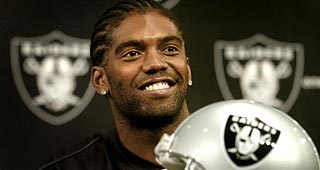There was a time not so long ago when a number in the teens predicted an early training camp demise for a wide receiver. If you didn't get one of those choice numbers in the 80s, chances were -- well, your chances weren't very good.
That was then and this is now in today's NFL:
Randy Moss, once the preeminent No. 84, is sporting No. 18 for the Silver and Black. Plaxico Burress, the erstwhile No. 80 in Pittsburgh, is a stylish No. 17 for the Giants. Even Jerry Rice, the most decorated wide receiver ever -- the ultimate No. 80 -- wore No. 19 in his final days with the Broncos.
"The younger generation, they look at those numbers in the teens as being cool," Rice said. "But back in the day, if you had 80, 81, even 88 -- I was No. 88 in college -- you thought it was pretty cool. But you have a new generation now."
It is the league's hottest fashion trend. A total of 30 wide receivers had numbers in the teens when the season kicked off. These numbers, for the players who wear them, are prime. In March 2004, the NFL -- faced with escalating retired numbers, an increasing emphasis on passing, and with it, more wideouts and tight ends -- allowed wide receivers to start wearing numbers 11-19, even if numbers in the 80s were available. Rookies and veterans changing teams were permitted to make the switch.
The first wave was the trio of rookie wide receivers who went in the top 10 of the college draft the following month. The Cardinals' Larry Fitzgerald, the No. 3 pick overall, Detroit's Roy Williams (No. 7) and Reggie Williams (No. 9) of the Jaguars all wore single digits in college (Fitzgerald and Reggie Williams both wore No. 1) and they all chose No. 11 as their new number in the NFL.
More WR's Choose Low Numbers With New Rule


